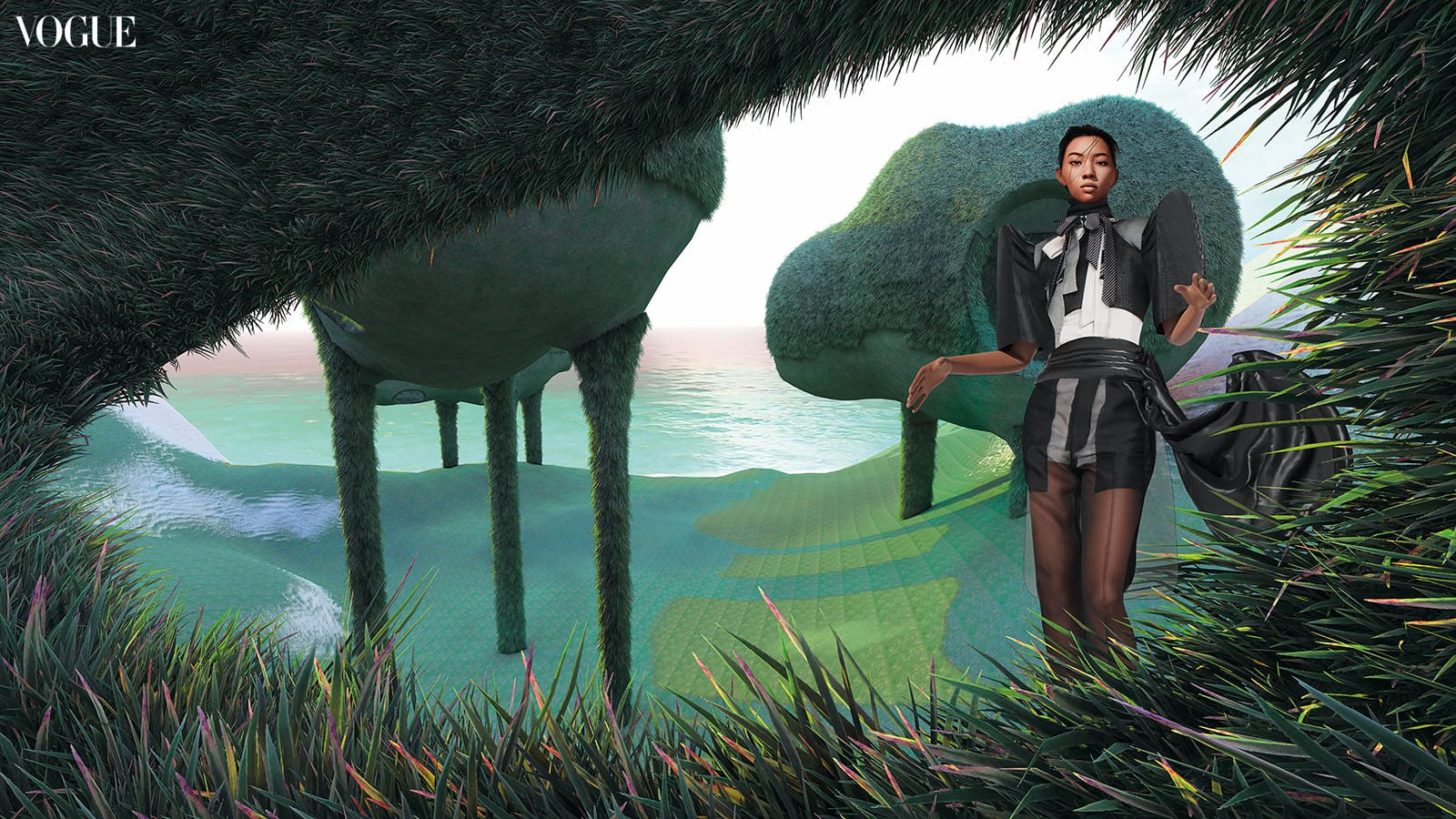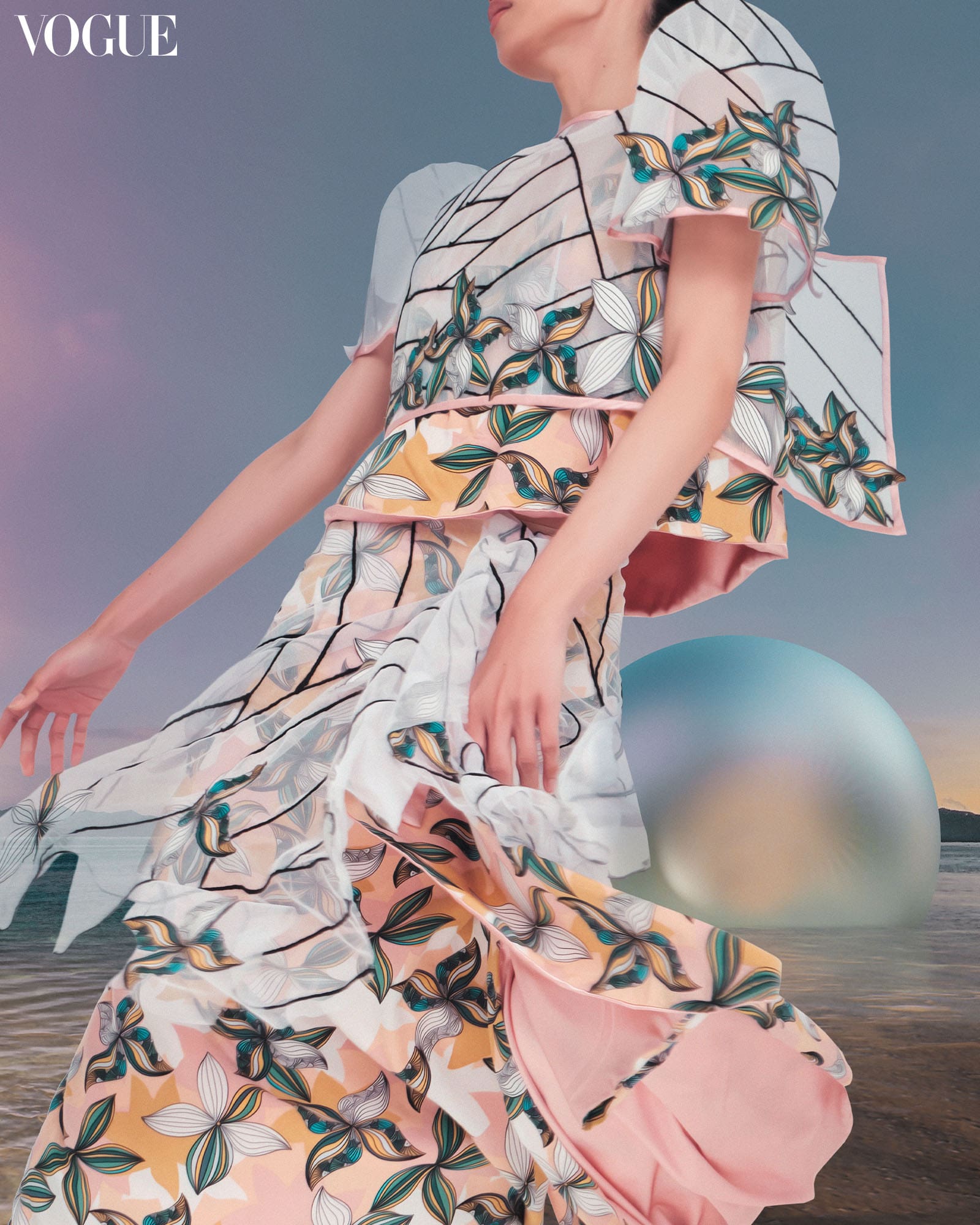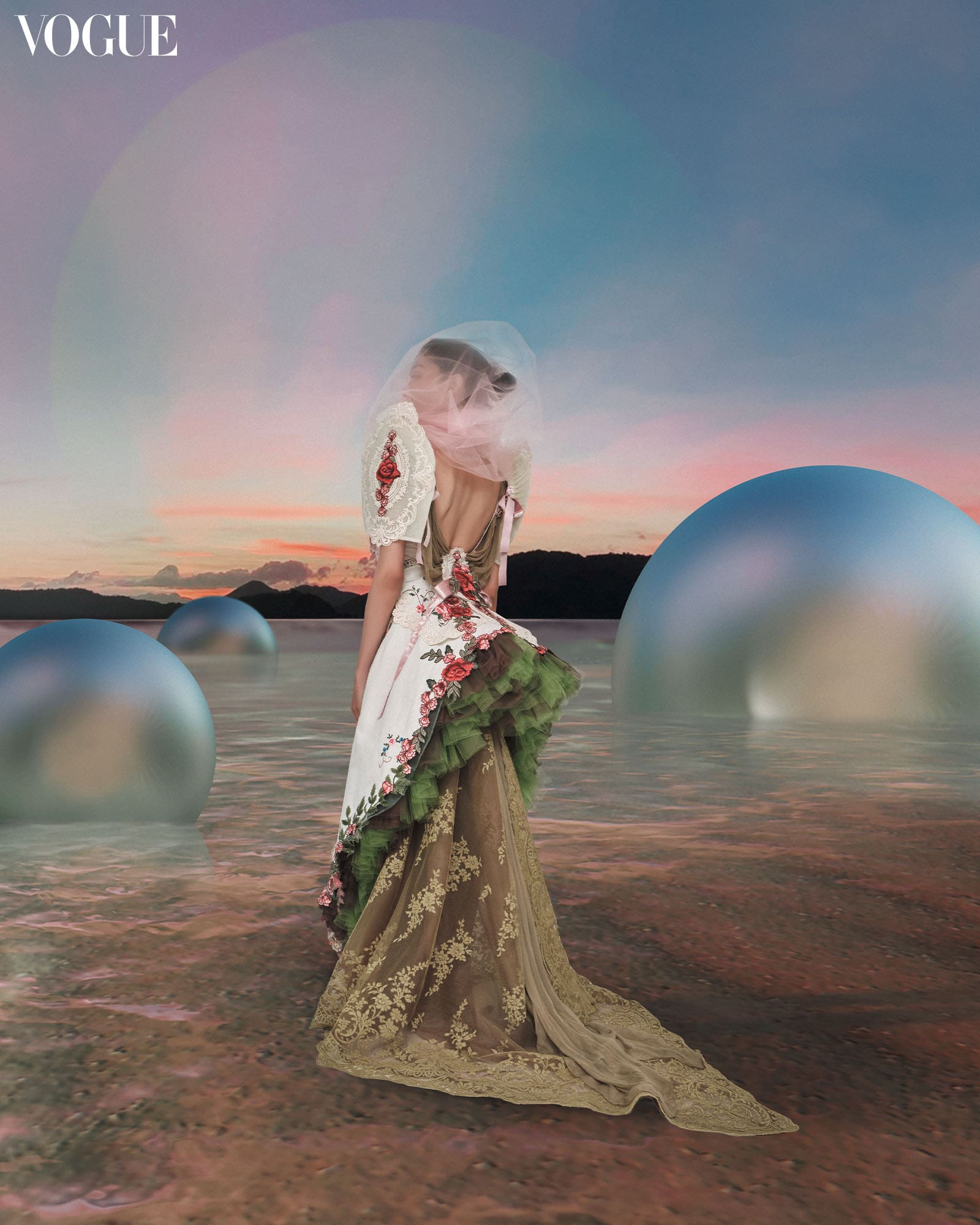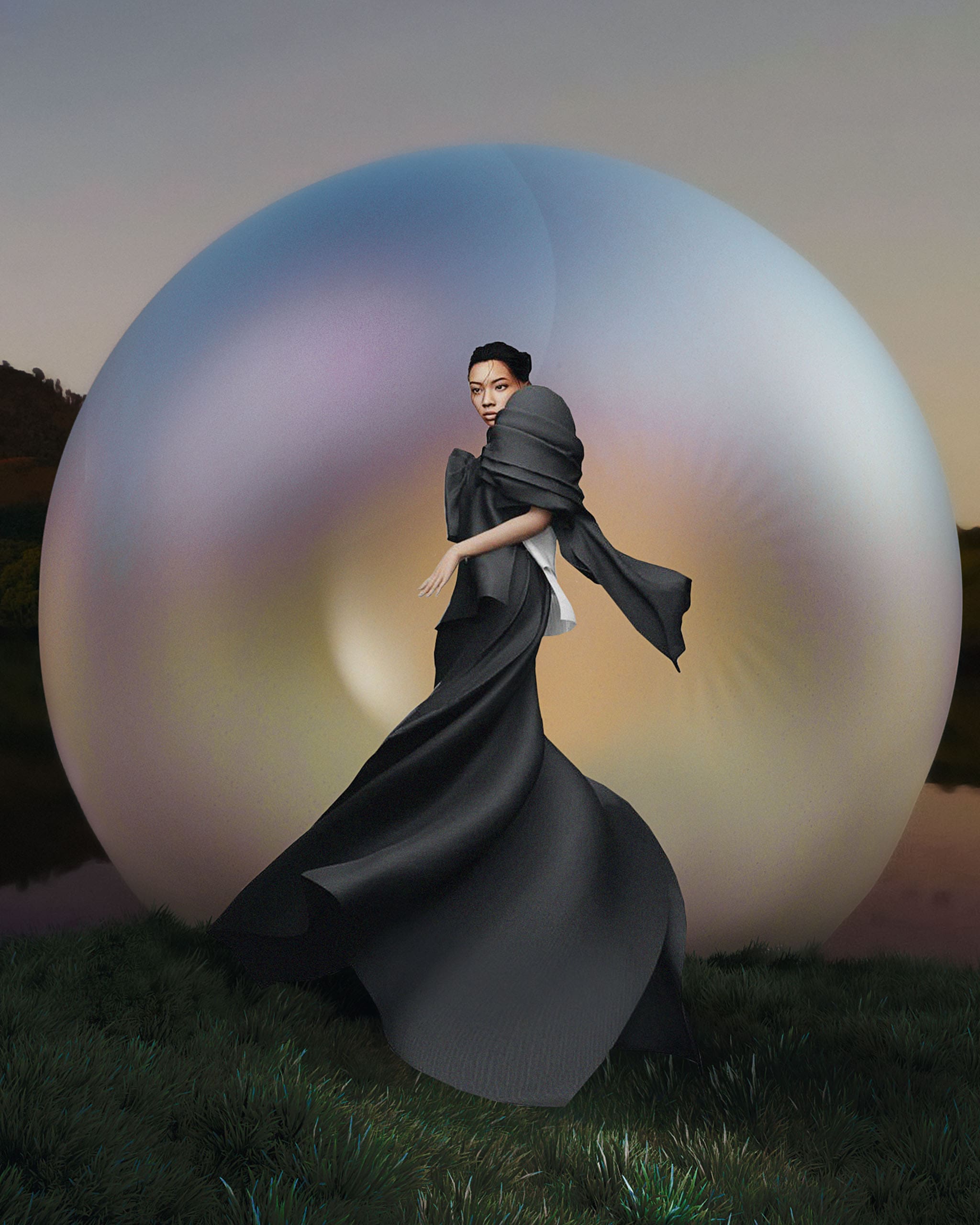Rendered digitally by DressX and Lablaco and are modeled by IVAN MEDRANO’s avatars against BIANCA CARAGUE’s landscapes.
The future of fashion is deeply-rooted in the heritage of everydaywear as the Balintawak is celebrated for the upcoming TernoCon.
“At the Puente Colgante in Quiapo the pilgrims boarded garlanded boats and sailed upriver to the music of rondalla. The menfolk were in camisachino and neckerchief; the women in balintawak. At Cainta or Taytay, where the voyage ended at noon, waited horses, wagons, carriages, and hammocks, of the afternoon trek uphill.”
The above passage, attributed to Nick Joaquin, describes the annual pilgrimage to Antipolo taken in the muggy month of May. Women—and some men—completed the last leg of the journey on a shaded hammock, hoisted by porters and carried in leisure to the top of the hill to visit the shrine of Our Lady of Peace and Good Voyage. Urbane ladies took advantage of these out-of-town jaunts to don their countryside outfits known as the balintawak, so much so that the three-piece dress has become associated with the scenic rural town.

A laid-back version of the terno that became popular in the 1920s and 30s, the balintawak harks back to the supposedly simpler life of the country. A series of hand-tinted photographs from the 1930s showing Manila women styled with agricultural props suggests that this countryside fashion was more of a look than a lifestyle, a studio recreation of Fernando Amorsolo’s romanticized vision of rural life. “They enthusiastically held up Japanese fans, baskets, clay pots, fishing tools and farming implements against painted backdrops depicting quaint rural scenery. The postcard photos were then distributed to friends and family with heartfelt dedications,” describes TernoCon artistic director Gino Gonzales in his essay “The Philippine Dress: 500 Years of Straddling Polarities.”
Gonzales notes that this pining for the province came in response to the rapid urbanization and Americanization that the Philippine capital was experiencing in that era. Fittingly, this year’s TernoCon, the third iteration of the intensive months-long terno design workshop and competition presented by the Cultural Center of the Philippines and retail giant Bench, is all about the balintawak. The pandemic has seen the exodus of many fortunate city dwellers to their seaside abodes or vacation farms. Those who remained locked down in their apartments took to slow-living pastoral pursuits like growing plants and baking bread. The balintawak, with its looser, softer forms and more festive patterns is the post-pandemic Filipino dress that speaks to our present balik bukid (or return to countryside) sensibilities.
“Its development cannot be simplified as pure adaptation, or a direct and exclusive imposition from Spain; rather, there was an interweaving of native and foreign traditions. The dress was European-inspired in construction, style, and silhouette, but native in material and ornamentation.”
Aside from the butterfly sleeves, there are other essential elements of the balintawak—the alampay, a multifunctional piece of cloth that is strewn over one shoulder, replacing the stiff, modesty-covering pañuelo, and the tapis, a matching piece of fabric that is wrapped or girded around the waist over the saya, replacing the more elaborate sobrefalda. (“Depending on the year, the balintawak may not necessarily be a three-piece ensemble,” Gonzales says. “At its height, it had four pieces: camisa, alampay, tapis, and saya.”)
The TernoCon designers, which include mentors, contestants, and previous winners, are free to interpret the alampay and tapis as they wish, but the sleeves are held to a stricter standard, being the last vestige of the ever-evolving terno.


The traje de mestiza, the terno’s precursor, came into fashion in the 19th century. It was a style that was neither completely indigenous nor completely foreign, both influenced by Western trends yet modified to suit the local context. “Its development cannot be simplified as pure adaptation, or a direct and exclusive imposition from Spain; rather, there was an interweaving of native and foreign traditions,” writes Stephanie Coo in her book Clothing the Colony. “The dress was European-inspired in construction, style, and silhouette, but native in material and ornamentation.”
In the 1920s, the couturier Pacita Longos—a favorite of Philippine high society at the time—began to pleat the upper part of the billowy sleeves of the traje, creating a flatter and more raised shape. With the invention of the butterfly sleeve, the terno as we know it began to take shape.
Inspiring the Next Generation
Of the four mentors, Dennis Lustico is known for his feminine silhouettes and has been a Paris Fashion Week fixé since 2016. He crafted a knee-length pink dress with the wispiest of butterfly sleeves and a suggestion of a tapis in sheer tulle. “From the lectures we had during our lock-ins with Gino, we learned that the balintawak is breezy, light, fragrant, floating and airy,” he says. “I didn’t want it to look heavy, either by fabrication or aesthetics. It had to be light.”
Under Lustico’s mentorship is Cheetah Rivera, who earlier made the international street style rounds when Heart Evangelista was photographed at Paris Haute Couture Week wearing a blue mini terno with 3D appliques that Cheetah designed. Rivera’s TernoCon entry captures the mood of Amorsolo’s paintings with floral motifs hand-embroidered on a terno top. “In Abra, I studied natural dyeing processes using organic materials like woods and plants,” she says. Using lagundi leaves, the top was imbued with its yellow hue.
Abdul Gaffar, a designer from Iligan who won the Chief Mentor’s Medal in 2020 for his white neoprene terno collection, hewed to the more traditional spirit of the balintawak for this TernoCon with a floral dress in a light chalice cotton. “My favorite detail about this piece is the lines created using the jute ropes, and also the sheer fabric, making the whole ensemble look light, easy, and comfortable to wear despite the amount of pieces layered on top of each other,” he says. “I think it represents well how the balintawak or terno was being done before and how it can still be used and done today.”

Another previous winner, Dinnes Obusan, won bronze in the last TernoCon for dresses sewn out of individual loops of neoprene and velvet, a laborious process that came to be his signature technique. His pared-down balintawak design highlights the tapis and how it was used as a cover-up—an image made famous by Amorsolo’s sensual renderings of Filipina women bathing in the river. Obusan used printed chiffon to create a single unit resembling a malong knotted at the shoulder, with two layers of yellow chiffon and lace peeking underneath. He explains that he chose the fabric for its lightness: “Magaan tingnan, tapos naisip ko bagay siya sa design na presko lang tingnan. Yung look na bagong ligo,” he adds.
Bon Hansen Reyes, a finalist from Rizal, is a menswear designer who has found a female fanbase among those who prefer androgynous styles and loose shapes. His gray bibbed balintawak veers away from the traditional femininity of the terno, using wool and tailoring techniques to create precise lines and folds. “The construction was quite difficult because it’s like I was solving a puzzle to assemble the pattern. Everything should be sharp,” he says. Though not a TernoCon entry, Bon’s black wool dress is distinctive for having his design DNA, which he describes as “not fitted, but boxy.”


Mentoring Reyes is Joey Samson, the designer who pioneered the menswear look for both men and women in the aughts. His two very different balintawak outfits demonstrate his range as a designer. The tuxedo-terno hybrid, done in sheer fabric and lace, is punctuated by a playful cluster of printed ties, bowties, and cravats that take the place of the alampay. His second dress exudes a nostalgic charm with a 1950s serpentine silhouette and swirly skirt layered with organza, tulle, and raw edge cotton, making it super swishy when set in motion.
Interestingly, it was Lustico who steered Samson toward menswear when the latter was a new member of the Young Designers Guild. Now, Lustico says that Reyes reminds him of Samson when he was starting out, someone who broke the rules. “It’s been very fulfilling to be able to share the knowledge we have, and the experiences we went through, with these young designers,” Samson says. “It’s fulfilling to say, in a way, that we can inspire other people.”
Ricky Toledo and Chito Vijandre, the design duo behind Firma and AC+632, are jointly mentoring the last third of the finalists. “Inno (Sotto, Chief Mentor) and Gino assigned the maximalists to us, the crafty ones who like beading and embroidery,” Toledo says. “They all happen to be out-of-towners, from Zamboanga, Cebu, Mindoro, and Davao. I’m in awe of the talent they have,” adds Vijandre.

The pair was already already working on their ten pieces for the TernoCon show, using upcycled materials foraged from their pandemic spring cleaning, when they got the balintawak memo. To make it to the press preview, they had to quickly tweak two ternos constructed with Madeira tablecloths and embroidered fabric from China. Sondheim’s “A Weekend in the Country” was playing on Spotify, giving them the Edwardian inspo for the outfits they presented with ornate, intricate, and even irreverent details. “Of course, a little of the baroque and belle epoch comes in. You can see there’s maybe a lot going on, which we had to edit eventually,” Ricky laughs. “We don’t really do casual.”
TernoCon 2020’s three mentors—Lesley Mobo, Ivar Aseron, and Philip Rodriguez—will be part of the judging panel on January 28, 2023, continuing the chain of mentorship and guidance that will keep the terno alive and in use well into the future. “I think it’s worked, the terno is more visible now,” Ricky and Chito agree, mentioning 2018 mentor JC Buendia who they say made it more casual and relatable. “It helped put the terno in the mainstream again and inspired the second TernoCon to push through.”
Could we be witnessing a new golden age of the terno, one where the butterfly sleeves are found on garments both formal and informal, structured and deconstructed, traditional and avant garde, real and virtual? It’s not necessary to turn the terno into everydaywear—the need is simply to make everyday Filipinos aware of how much of our country’s history can be told in the story of two sleeves. The terno, even a hundred years later, still offers a canvas on which Filipino designers and artists can chart a national identity, using craft, collaboration, and creativity to transport us into possible worlds and new futures.
This story originally appeared in Vogue Philippines’ December-January 2023 Issue. Subscribe here.
Photographs: Shaira Luna. Fashion Director: Pam Quiñones. Sittings Editor: Ticia Almazan. Model: Taki Shimada. Avatar Designer: Ivan Medrano. Landscape Designer: Bianca Carague. Digital Fashion: DressX, Lablaco. Producer: Anz Hizon. Production Assistant: Adam Pereyra. Special thanks to Gino Gonzales of TernoCon.
